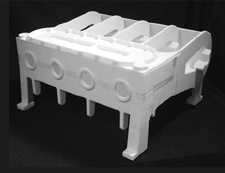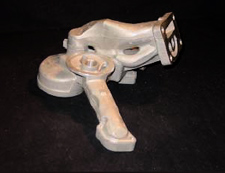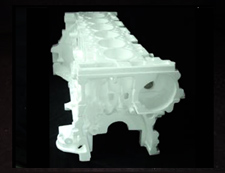
Wright Flying Machine - Engine Crankcase
Fabricated foam used to build two
engine crankcases for a 100th Anniversary
Wright Flying Machine replica aircraft.
|

Dual Oil Filter for Diesel Engine
Fabricated Foam used in developing
new casting design. Project became highly
successful Lost Foam award winner.
|

6-Cylinder Engine Block
Fabricated Foam methods used to develop new engine block design. Note: Block shown is previous design and is similar to
actual casting made.
|
SLA, SLS, LOM. So Why Not LFC?
SLA, SLS, LOM
All are acronyms for prototyping. All have in common the ability to produce a model of a part from 3-D data but all struggle to make that model useful in the casting process. We believe we have an answer to this problem.
The SLA, SLS and LOM formats are, at best, marginally useful as a sand pattern for use in making iron or non-ferrous castings. The limitations include surface finish, strength and dimensional stability. Additionally, machine formats are small compared to parts cast in iron. This requires several prototype patterns be joined together to make one larger pattern.
Using these formats, a prototype supplier can also develop what is essentially an investment casting. Building a shell around the pattern, eliminating the pattern from the shell and firing to create and investment cast cavity, allows the prototype pattern to be poured in an investment casting facility. This process is best used for small parts and for non-ferrous parts.
Some attempts have been made to print a shell around part data and to eliminate the pattern. This is still a niche market, primarily for smaller parts and non-ferrous parts. Surface finish and dimensional accuracy are pointed to as shortcomings.
LFC
Lost Foam Casting using Fabricated Foam Patterns has the ability to overcome many of the problems associated with the other prototyping processes. The advantages lie in the ability to make larger parts, to make iron castings and to make prototypes in a production facility with production techniques.
Dimensions can be controlled so that they are repeatable and similar to, or better than, sand and permanent mold casting. As an added benefit, parts do not need the draft required to make a sand casting pattern, a feature that
can save design time and allow earlier prototyping.
So why not LFC with Austin Group for your prototypes?
|

